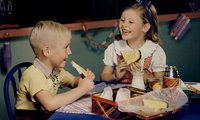 Corn dogs, canned fruit and a bag of chips…that was a typical hot lunch offering at the posh private school my daughter attended in Marin County, California six years ago. It took me, and five other Marin moms, more than a year to initiate organic lunch programs in our local private schools. We had to work hard to convince parents and administrators that it was worth an extra $1 a day to serve organic food to our kids.
Corn dogs, canned fruit and a bag of chips…that was a typical hot lunch offering at the posh private school my daughter attended in Marin County, California six years ago. It took me, and five other Marin moms, more than a year to initiate organic lunch programs in our local private schools. We had to work hard to convince parents and administrators that it was worth an extra $1 a day to serve organic food to our kids.
There are still many schools in my county where kids are given unhealthy (highly processed, microwaved and packaged) foods and drinks (soda and high fructose corn syrup sweetened juices) on campuses and in cafeterias. Instead of real and nutritious food, they are eating food that doesn’t help their brains or bodies develop optimally.
“If we can’t fix the broken parts of our lunch program here in this community, with our incredible bounty of organic local food, our ready and able thought leaders, organizations, students and community members, then who in the U.S. can?” said Judi Shils, Founder/Director of Teens Turning Green which just launched Project Lunch, a community-based action group to help mentor school lunch programs. Its goal is to ensure that every child in every school has the opportunity to eat healthy food at lunch, and to understand the vital connection between health food and a healthy mind, body, and earth.
Hopefully, in this current climate of health awareness, Judi’s Lunch Project will go smoother than my endeavor to improve the food at school six years. My experience looked something like this:
I, along with five other moms from different private schools in my area, organized a food committee and enlisted the help of parents, teachers and staff. We sent out a survey to the parents asking if they’d be interested in their child receiving an organic lunch and if they’d be willing to pay one or two dollars more per day than what they were paying for corn dogs, canned fruit and chips. We received comments back like “My child won’t eat bean sprouts!” or “My child likes to eat tasty food!” I had to explain that organic didn’t mean either of those…it just meant there would be no pesticides or artificial colors and sweeteners or genetically modified organisms.
After we finally got the go-ahead from the parents and heads of schools, we interviewed a series of caterers and local organic markets. One called Good Earth, an organic and natural foods market in Fairfax, California won – their food passed the taste test (we had kids sample the food) and they were less expensive than the caterers. Good Earth hired a chef and rented a facility to accommodate our needs, since this was their first venture into a large-scale lunch program. It was agreed that the food would look and taste as similar to the food the kids were already getting (no corn dogs!) in their current hot lunch program, only healthier.
Since they didn’t make pizza they way the kids were used to seeing it, Good Earth contracted with a local pizza parlor and supplied them with organic whole wheat pizza dough. I watched with anticipation that first day the new, organic pizza was delivered. And you know what? The kids hated it! They wouldn’t eat it. It was too dry they said. So a compromise was made and from then on, all the pizza, bread and pasta would be made from organic white flour instead of whole wheat.
The challenges continued. I was also on a committee to plan a school picnic. The majority of the parents on the committee voted for hot dogs, pizza, watermelon and soda. I raised my hand and asked if it would be possible to have organic food at the event. The chair of the committee said: “No, we’re just going to have normal food.” I countered with, “So, by normal, you mean food that’s been sprayed with pesticides?” There was silence. Then I asked if we could at least have organic watermelon. “What are you… a Food Nazi?” the chairperson asked. (It’s hard to believe that this conversation took place in Marin County!) This time the silence came from me. I decided to ignore her question and volunteered to call one of the local farms and have organic watermelons delivered to our picnic.
Currently the organic hot lunch program is running smoothly, and Good Earth now serves over 4,000 kids a week in 9 Marin County schools. Admittedly, it may be easier to get a program going at a private school than at a public school offering a low-cost or free lunch program because of the bureaucratic approval process involved.
It’s up to us to make requests to our school boards to make healthy changes in the meals and snacks that include less sugar, trans fats and high fructose corn syrup, and more fresh foods, whole grain items, and organic or local ingredients. Remember, children are consuming as much as 50 percent of their calories during the school day. And leading generals and admirals are telling us that a quarter of young people are too overweight to serve their country in uniform. Consider including preschools, daycare, Sunday school, and colleges. Think about the transformation that can occur if we had fewer cases of obesity and diabetes!
It’s in line with First Lady Michelle Obama’s “Let’s Move” initiative which supports healthier food in schools by, among other things, increasing funding for school meals, promoting farm-to-school programs that get fresh fruits and vegetables into school cafeterias, and updating nutrition standards for the foods sold in vending machines. In addition, The House Education and Labor Committee is working on the Improving Nutrition for America’s Children Act. Testifying before the committee, Top Chef and restaurateur Tom Colicchio said, “There can be no better investment—no better stimulus to our economy—than feeding this nation’s children healthily and well. If we give the kids in this country delicious and nutritious food, we will instill in them a lifetime preference for healthy eating that will translate into vast savings in health care costs down the line.”
There’s never been a better time to instigate changes in how our school systems buy, prepare, and serve food to our kids! For more information on creating an organic hot lunch program at your school contact: Project Lunch, and look at Chapter 10 in my book Super Natural Home where I offer “10 Steps on Creating an Organic School Lunch Program at Your Child’s School.”
Beth Greer, Super Natural Mom™, is the bestselling author of Super Natural Home, host of “Your Super Natural Life” on Clear Channel’s Green 960 Radio, and impassioned champion of toxin-free living who busts open the myth that our homes are safe havens. Follow Beth on Twitter. Become a fan on Facebook.


